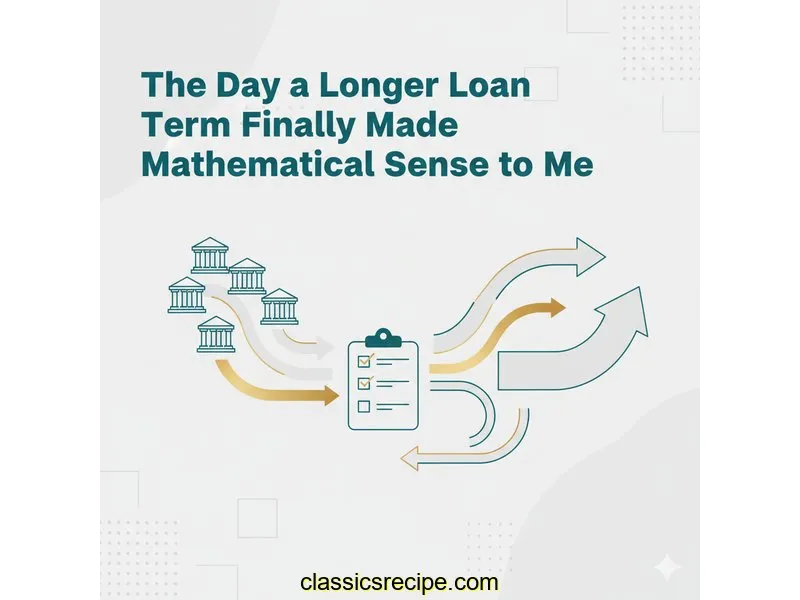
Auto Loan Calculator
Calculate payments over the life of your Loan
Home Blog Privacy Terms About Contact
Calculate payments over the life of your Loan
Home Blog Privacy Terms About ContactPublished on October 14, 2025

My journey into the weeds of loan calculations started with a simple, offhand comment from a friend. We were talking about his recent kitchen renovation, and he mentioned taking out a three-year loan instead of the five-year option he was offered. "The monthly payment is a bit higher," he said, "but it works out better." I nodded along, but internally, my brain hit a snag. Higher payment means more expensive, right? Why would anyone choose to pay more each month if they didn't have to?
This seemingly simple question lodged itself in my mind. For days, I couldn't shake it. How could a higher payment be the "better" choice? It felt counterintuitive. I thought the goal was always to have the lowest possible monthly bill. My curiosity got the best of me, and I decided I needed to understand the math behind this myself. My goal wasn't to decide which loan was better, but to simply understand the mechanics. How does changing the number of months fundamentally alter the entire financial equation of a loan?
My first stop was an online loan calculator. I felt a bit like a detective opening a new case file. I found a few different ones and started plugging in some hypothetical numbers. I entered a loan amount, an interest rate, and a term. The calculator would instantly spit out a monthly payment. It felt like magic, but it didn't answer my core question. I was just seeing the outputs without understanding the engine running underneath.
I realized I was treating the calculator like a magic box instead of a learning tool. The numbers were just appearing on the screen, but they didn't tell a story yet. My initial attempts were aimless because I was only looking at one number—the monthly payment—without considering its relationship to everything else. This is my journey of moving past that single number. Just a heads-up, this is about understanding how calculations work, not financial advice. It's about my personal quest to connect the dots in loan math.
My initial confusion was rooted in a very specific, and I later learned, very common mistake. I was laser-focused on the monthly payment figure as the ultimate measure of a loan's cost. To investigate my friend's logic, I set up a test scenario in a calculator. I imagined a loan for a project, say, $13,850 at an interest rate of 7.2%.
First, I entered a 60-month (5-year) term. The calculator showed a monthly payment of around $274.24. "Okay," I thought, "that seems manageable." Then, I changed only one variable: the term. I switched it to 36 months (3 years), just like my friend did. The new monthly payment jumped to $429.35. My immediate, gut reaction was, "See? It's over $150 more expensive every month! The 5-year option is clearly the cheaper one."
I was so confident in this conclusion that I almost stopped there. My flawed logic was simple: lower monthly payment equals a better deal. I was completely ignoring the "per month" part of the equation. For a few hours, I was stuck in this loop, convinced that stretching out payments was some kind of financial hack to make things cheaper. I was comparing a single payment of $274 to a single payment of $429 and drawing a conclusion based on just that.
The frustration began to set in when I tried to think about the *total* amount paid. My mental math was fuzzy. I knew I had to multiply the payment by the number of months, but I kept getting tangled up. Was I just paying back the $13,850? If so, why were the monthly payments different? This is where I realized I was missing a massive piece of the puzzle: the interest. I was thinking about the loan as just the principal amount divided by the months, completely forgetting that borrowing money has a cost that accumulates over time.
My breakthrough came not from a complex formula, but from a small, unassuming field on an online calculator that I had initially overlooked. While clicking around, I noticed a button labeled "Show Amortization Schedule" or "View Full Report." When I clicked it, a detailed breakdown appeared, and one line item jumped out at me: "Total Interest Paid." It was my "aha!" moment.
I realized I had been so fixated on the monthly cash flow that I completely ignored the total cost of borrowing. This single field held the key to my friend's logic. I immediately went back to my experiment, determined to use this new piece of information. I would keep the loan amount and interest rate identical and only change the term. This way, I could isolate its true impact.
The first step in my real learning was treating the calculator like a science experiment. By keeping the loan amount ($13,850) and interest rate (7.2%) constant, I could be certain that any difference I saw was caused *only* by the change in the loan term. This simple act of isolating one variable at a time made the relationship between the numbers crystal clear.
The next concept that clicked was visualizing interest. I started to think of the loan balance as a bucket of water that I was trying to empty. Interest is like a slow, steady rain that keeps adding water to the bucket. With a longer term (60 months), the "rain" has 24 extra months to fall compared to the 36-month term. Even though the monthly payment is smaller, you're fighting against that accumulating interest for a much longer time.
Finally, I understood what the higher monthly payment actually *did*. By looking at the amortization schedule, I could see that with the $429 payment, a larger chunk went towards reducing the principal balance each month, especially in the early stages. This meant the "bucket of water" was shrinking faster. When the principal shrinks faster, the amount of interest calculated on it in the following month is smaller. It creates a snowball effect of paying the loan off more efficiently.
To confirm my new understanding, I ran another test. I imagined a different loan, this time for $19,500 at 6.8%. First, I calculated a 72-month (6-year) term, which resulted in a total interest cost of $4,243.68. Then, I calculated a 48-month (4-year) term. The total interest dropped to $2,821.92. The pattern held. The lower monthly payment of the longer-term loan came at the cost of over $1,400 in extra interest. I finally understood my friend's choice from a purely mathematical standpoint.
This whole experience was incredibly eye-opening. It wasn't about which loan term is "good" or "bad," but about understanding the mathematical trade-offs involved. It taught me to look beyond the surface-level numbers and see the mechanics at play. Here are the key lessons I learned about the calculations themselves:

As I went through this process, I had a lot of questions. Here are a few that I had to figure out, framed in a way that I hope helps others understand the calculation side of things.
The calculation spreads the total amount you need to repay (principal plus all future interest) over a larger number of months. Think of it like slicing a pizza. If you have to pay back $15,000, dividing it into 36 slices (months) will result in bigger slices (payments) than dividing it into 60 smaller slices. The catch is that with the 60 slices, you're also adding more "topping" (interest) along the way.
From my learning journey, the most revealing field is "Total Interest Paid." This number strips away the principal you're just paying back and shows you the actual amount it cost you to borrow the money. Comparing this figure between two loan scenarios with the same principal amount gives you a direct, apples-to-apples view of the borrowing cost.
A calculator first determines your fixed monthly payment using a complex formula. Then, it calculates the total amount you will pay over the life of the loan (Monthly Payment x Number of Months). Finally, it subtracts the original loan principal from that total. The leftover amount is the total interest you will pay.
Yes, this is exactly what an amortization schedule shows. It's a table that breaks down every single payment you make over the loan term. For each payment, it shows you precisely how much money is going toward interest and how much is going toward reducing your principal balance. Seeing this breakdown was a huge part of my learning process.
My biggest takeaway from this entire exploration wasn't about three-year versus five-year loans. It was about the empowerment that comes from understanding the "why" behind the numbers. I started with a simple question born from a friend's comment and ended up with a much deeper appreciation for the mechanics of borrowing. The relationship between the loan term, monthly payment, and total interest is a perfect example of a trade-off that is purely mathematical.
Seeing the "Total Interest Paid" for my example scenarios—$1,606.60 for the shorter term versus $2,604.40 for the longer one—was the moment the lightbulb went on. The lower monthly payment came at a clear, calculable cost. Understanding this doesn't tell you what to do, but it gives you the knowledge to see the full picture.
I hope my journey encourages you to play with these calculators, too. Don't just look for an answer; try to understand how the answer changes when you adjust the inputs. It's a fascinating way to build your financial literacy and feel more confident when looking at numbers. I'm Alex, and this has been another step in my journey to make sense of personal finance math.
This article is about understanding calculations and using tools. For financial decisions, always consult a qualified financial professional.
Disclaimer: This article documents my personal journey learning about loan calculations and how to use financial calculators. This is educational content about understanding math and using tools—not financial advice. Actual loan terms, rates, and costs vary based on individual circumstances, creditworthiness, and lender policies. Calculator results are estimates for educational purposes. Always verify calculations with your lender and consult a qualified financial advisor before making any financial decisions.
